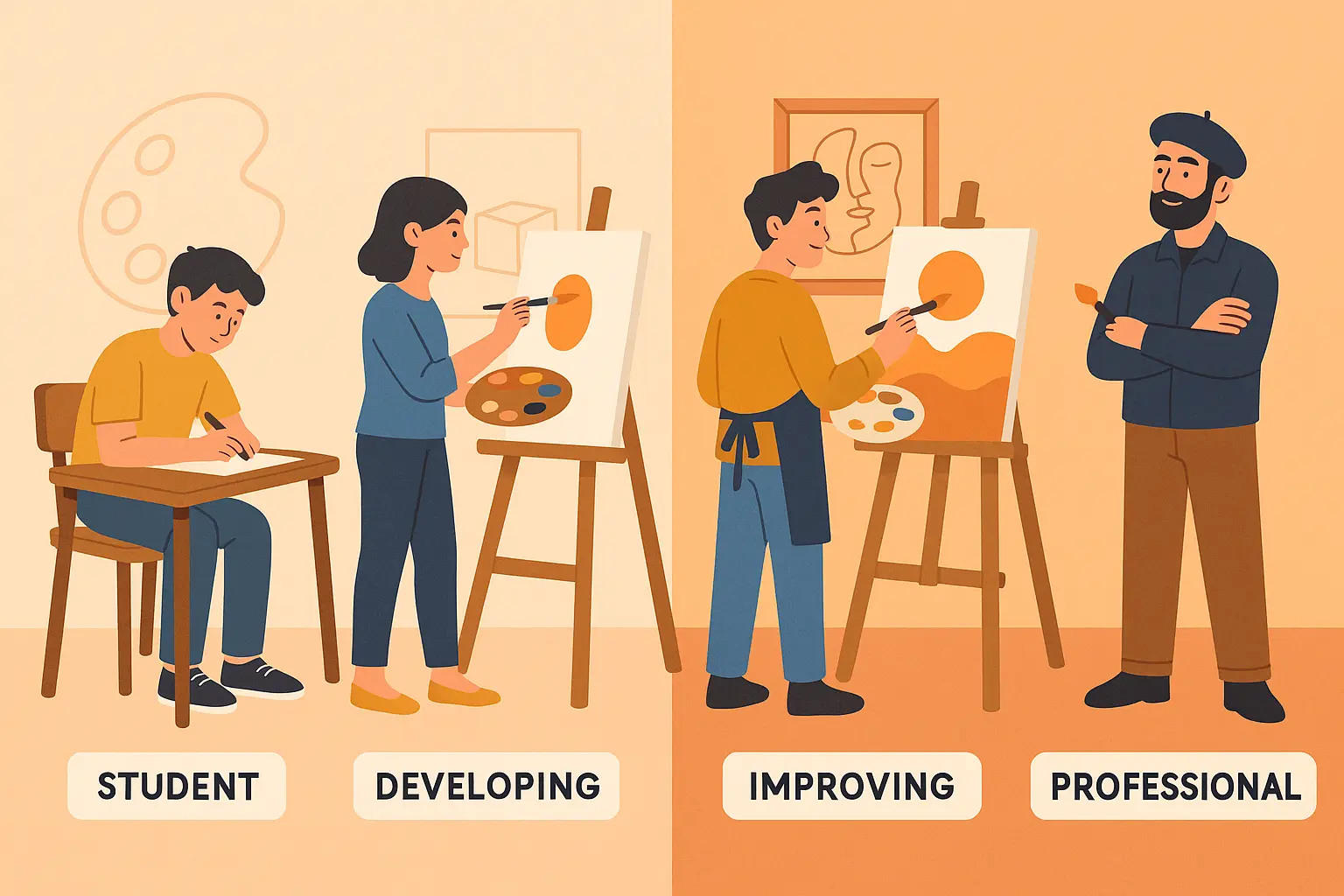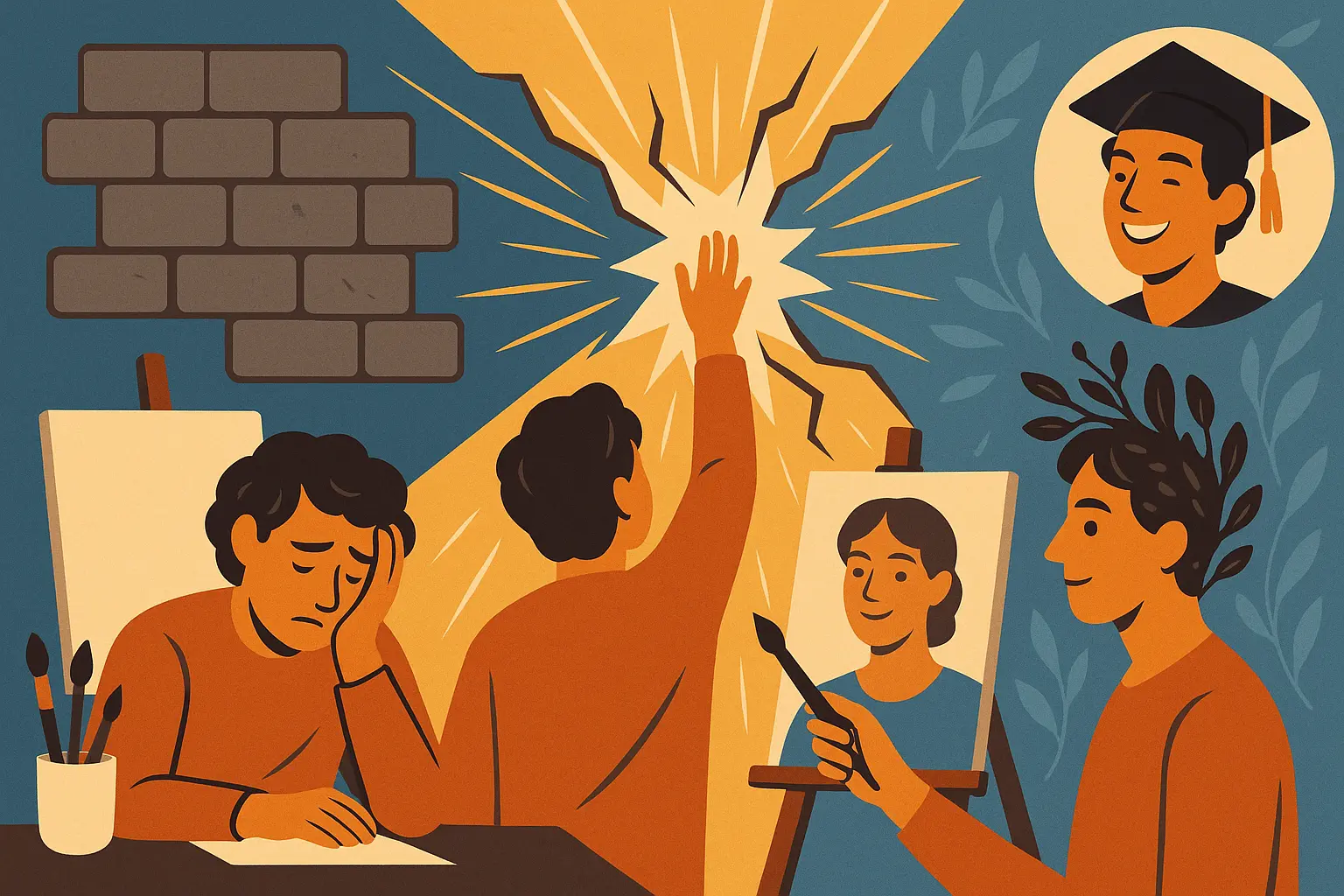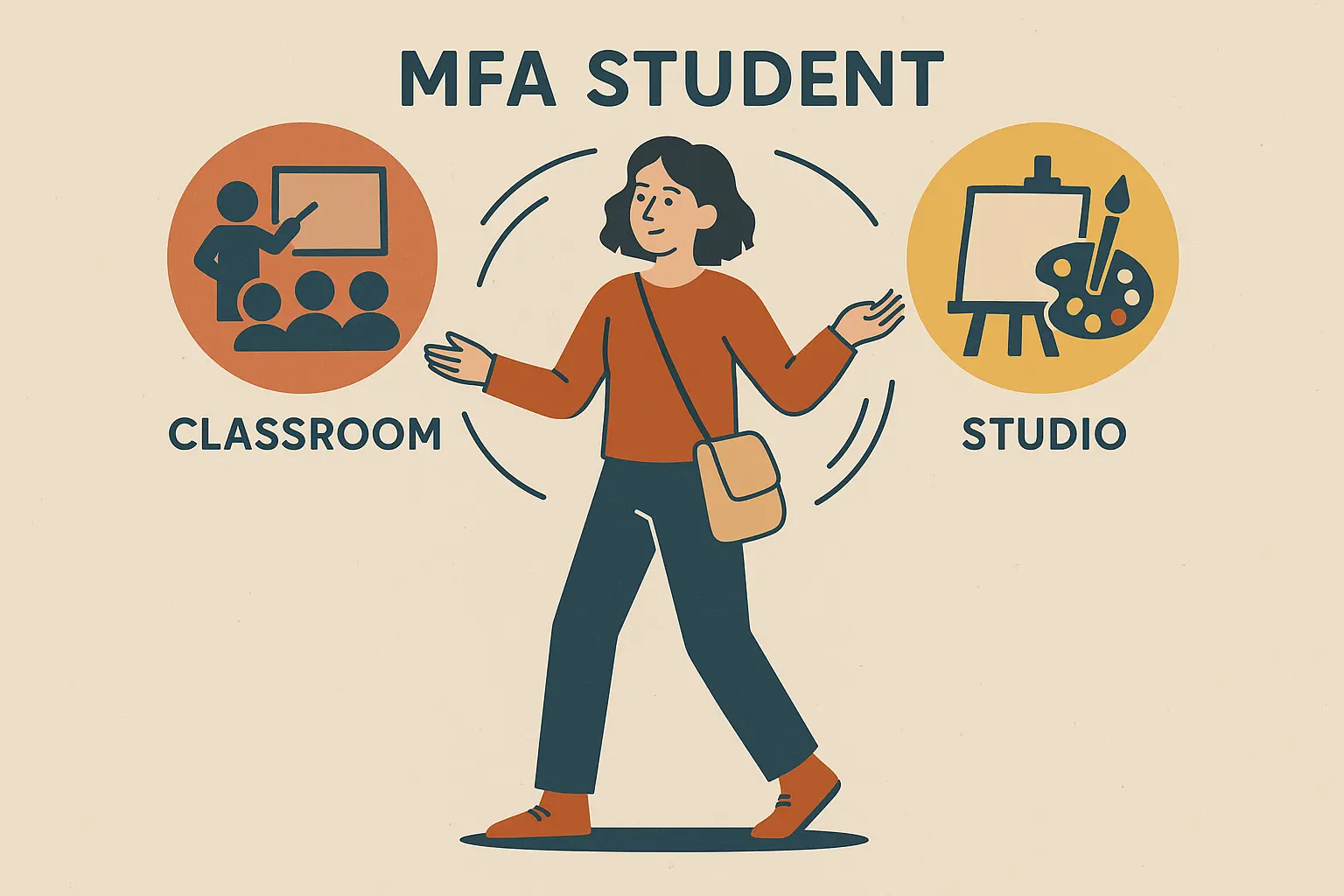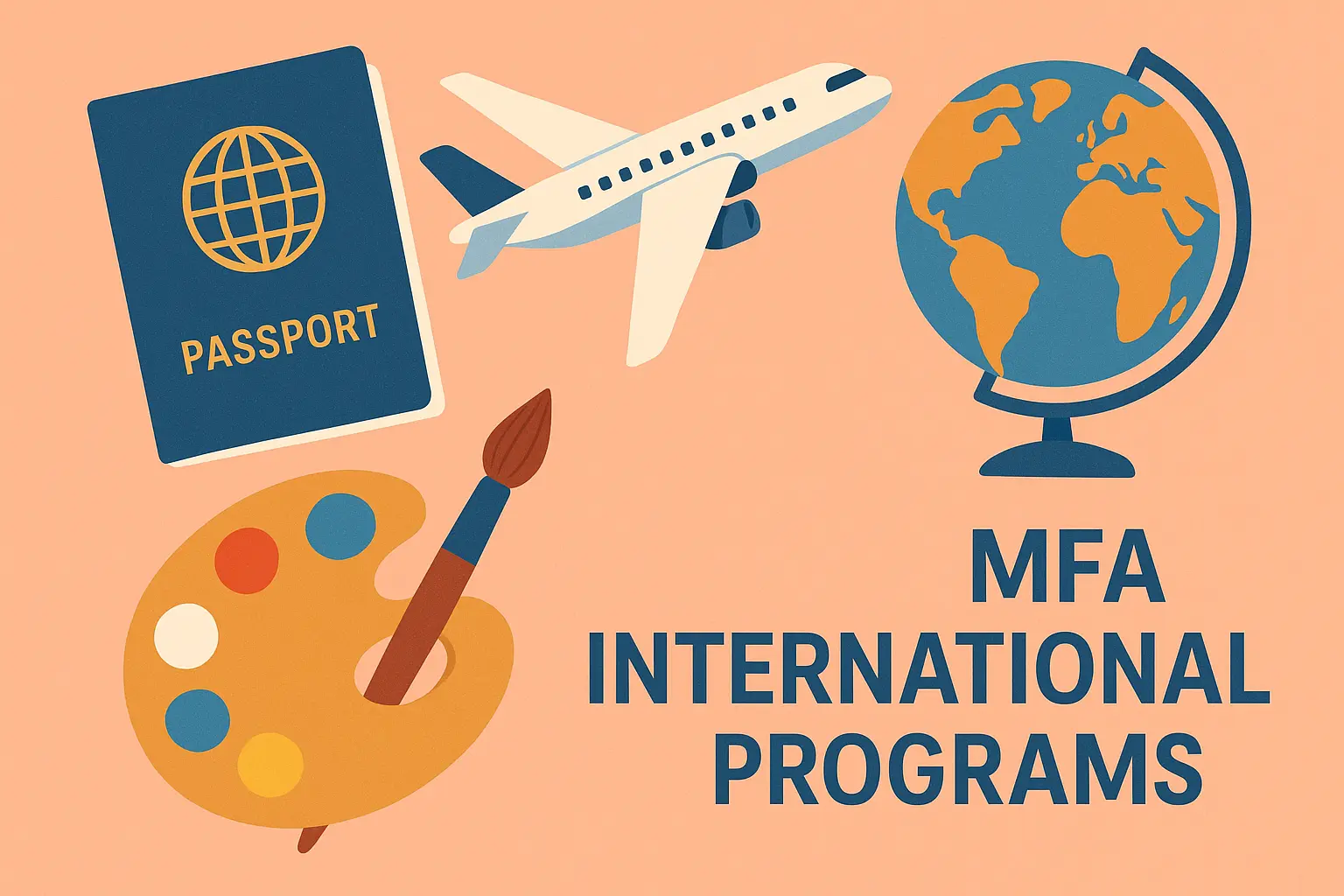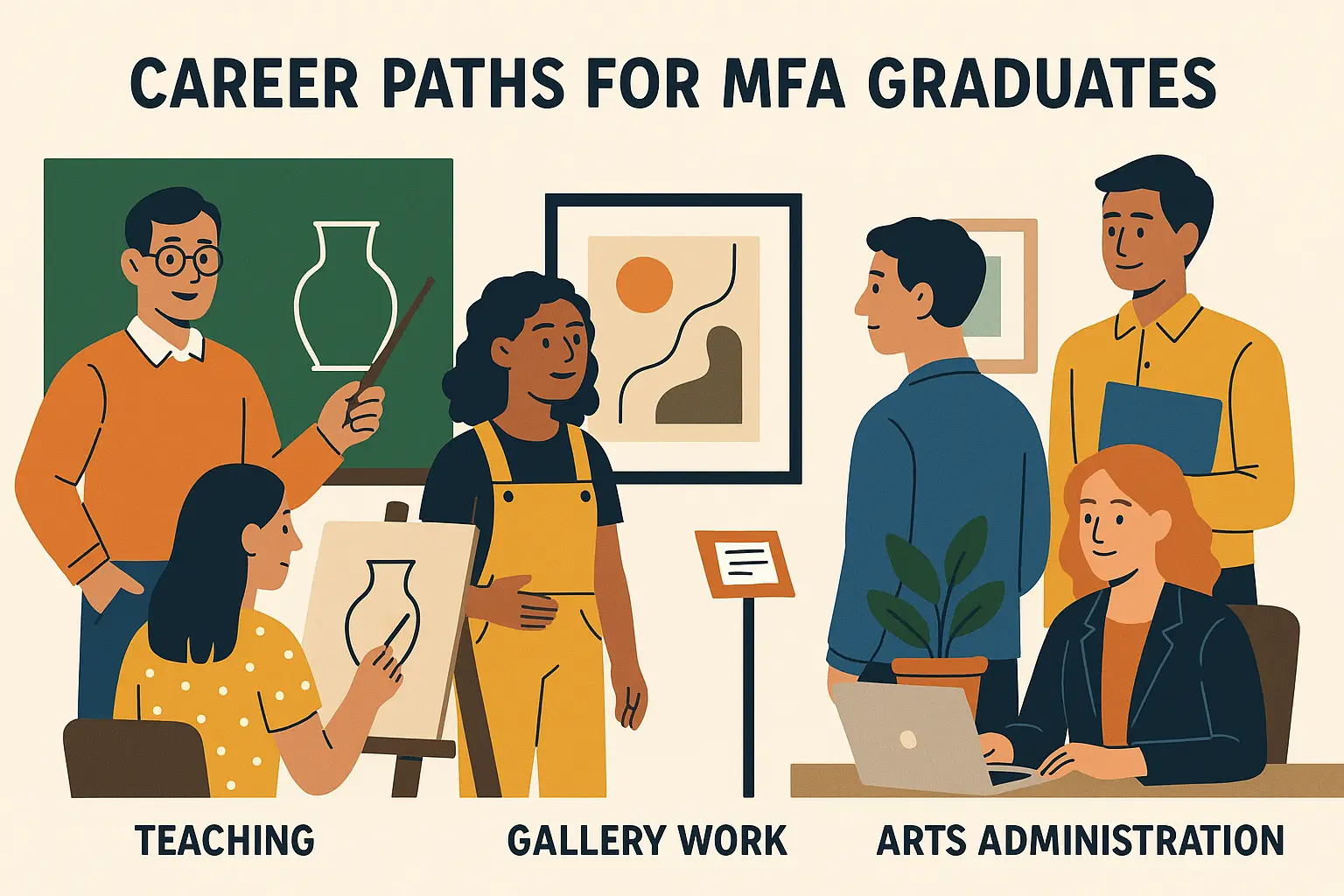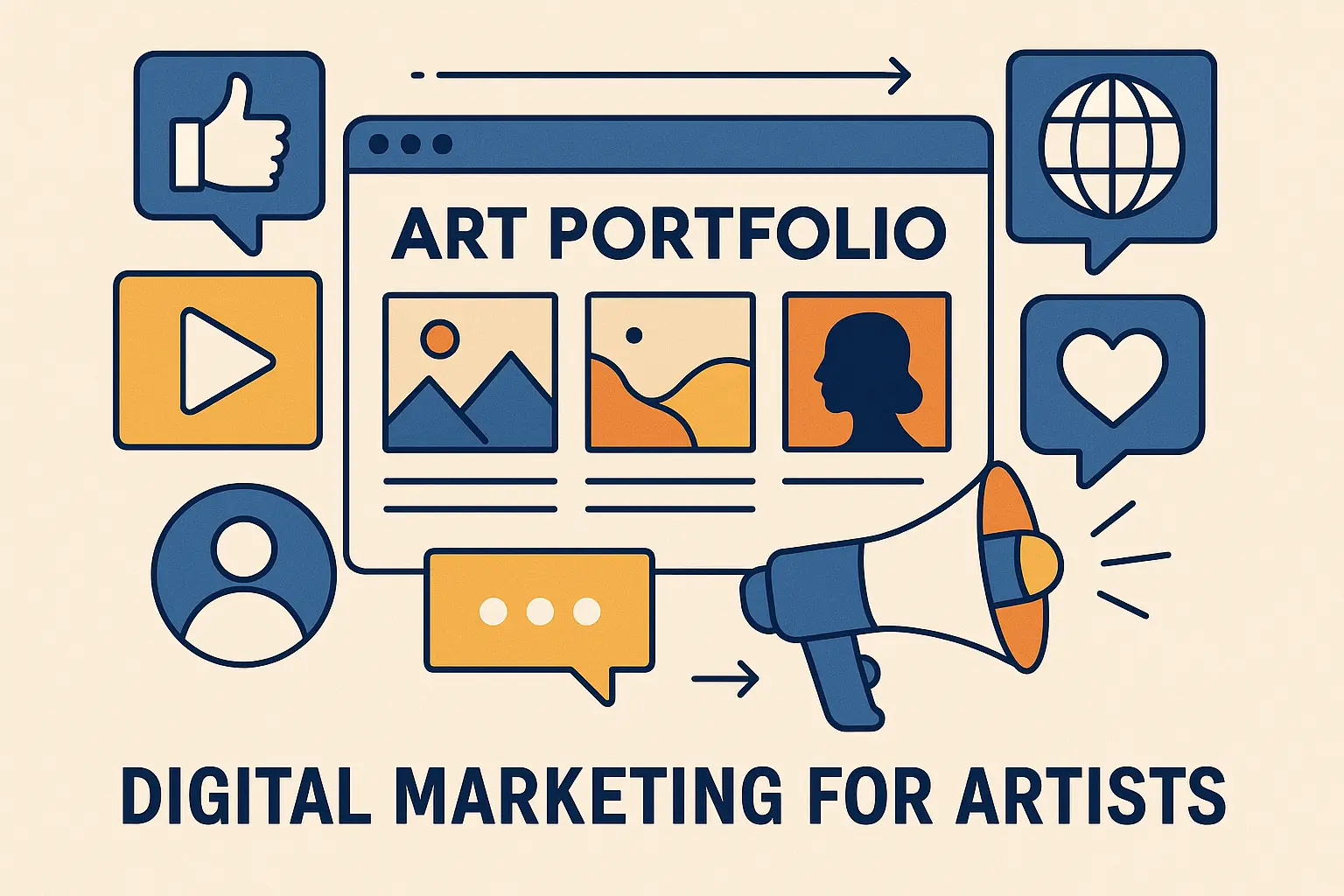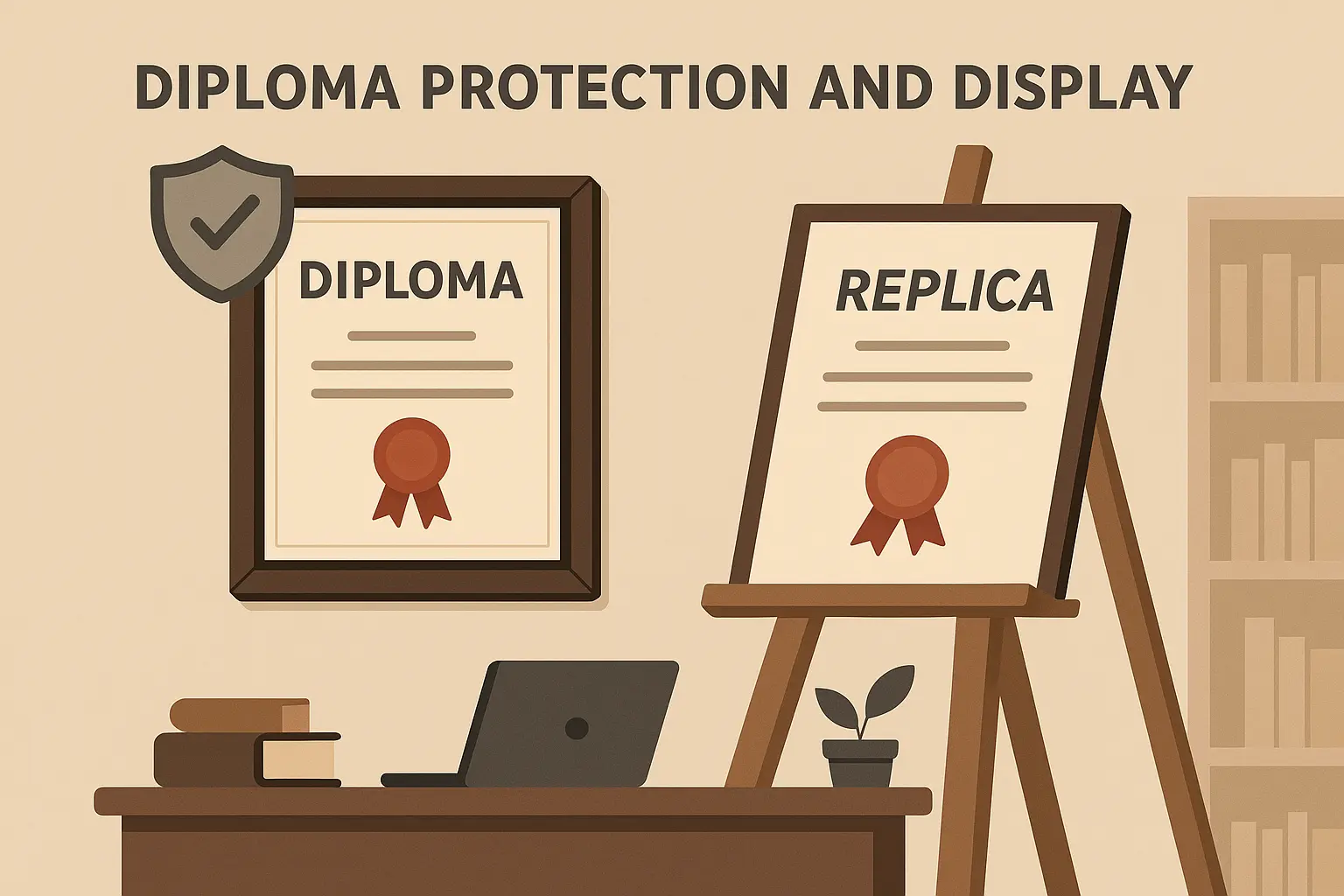When I started my MFA, everyone told me it would take 2-3 years. What they didn’t mention? I’d still be figuring out how to be a “real artist” two years after graduation. Turns out, nobody talks about the messy, complicated parts of getting an MFA – the parts that actually matter.
Here’s the truth: getting an MFA isn’t just about counting semesters. You’re signing up for a complete identity overhaul that typically takes 4-6 years from start to finish. This isn’t failure – it’s the hidden reality of artistic education that programs conveniently forget to mention in their glossy brochures.
With more than 200 MFA in Creative Writing programs in the United States according to the Poets & Writers database, you’d think someone would be honest about what you’re really getting into. Spoiler alert: they’re not.
Table of Contents
-
What an MFA Degree Actually Represents Beyond the Classroom
-
The Psychological Investment That Extends Your Timeline
-
Financial Pressures That Add Hidden Months to Your Degree
-
Program Formats That Completely Change Your Timeline
-
The Post-Graduation Reality That Completes Your Investment
-
Digital Documentation Requirements Nobody Warns You About
-
How ValidGrad Protects Your Hard-Earned Credentials
Here’s What I Wish Someone Had Told Me About MFA Timelines:
-
Those standard 2-3 year timelines? Forget them. You’re looking at 4-6 years of actually becoming the artist you want to be
-
That TA position that’s supposed to help? You’ll spend more time explaining grammar to freshmen than working on your art
-
Low-residency programs sound flexible until you realize you have zero self-discipline
-
Your portfolio will go through at least four complete overhauls, and you can’t schedule artistic breakthroughs
-
The real learning happens after graduation when you’re trying to figure out how to actually make it as an artist
-
You’ll spend way too much time trying to photograph your work without it looking terrible
-
That moment when someone asks “what do you do” and you still don’t know if you can call yourself an artist? That lasts longer than you think
What an MFA Degree Actually Represents Beyond the Classroom
An MFA isn’t just another master’s degree – it’s your official ticket into the “I’m a real artist now” club. Except here’s the thing: getting the ticket doesn’t automatically make you feel like you belong in the club. This transformation takes 3-5 years of sustained work, and your degree program is just the warm-up act.
Understanding what is an mfa degree means accepting that it’s more like a really expensive, really intense therapy session that happens to involve a lot of art-making. Like other master’s degree programs, it requires way more time investment than anyone admits upfront.
The Professional Artist Certification Process
Unlike other graduate programs that train you for jobs that already exist, an MFA certifies your transition into something much weirder: professional artistry. You’re learning to balance making art with the business side of art, which is like learning to juggle while riding a unicycle. On fire.
Finding Your Artistic Voice Takes Forever (And That’s Normal)
Your artistic voice – that magical thing everyone talks about – typically takes 3-5 years to develop. Your coursework gives you the foundation, but the real artistic growth happens through years of making terrible art, having breakthroughs at 2 AM, and slowly figuring out what you actually want to say.
Take my friend Sarah. She started her MFA making pretty landscape paintings that looked like every other landscape painting. By her second year, she was gluing random objects to canvases and calling it mixed media. It wasn’t until 18 months after graduation – after moving studios twice and having what she calls her “quarter-life crisis” – that she developed her signature style combining environmental photography with sculptural elements. Her voice emerged through sustained exploration, not because a syllabus told her it was time.
Learning to Be a Professional Artist Is Ongoing
You’ll spend years after graduation learning to balance creative work with the business side – applying for grants, dealing with galleries, managing your career. Your MFA gives you artistic credibility, but it doesn’t teach you how to invoice clients or negotiate with gallery owners. That education continues long after you walk across the stage.
Your MFA as Long-Term Investment (That May Not Pay Off for Decades)
Your degree functions as your entry ticket into art world conversations and networks. The real value comes through relationship building and cultural participation that happens over decades, not semesters. This means your investment timeline spans your entire career, with benefits you might not see for 10-15 years.
Those Institutional Connections? They’re Playing the Long Game
Access to alumni networks, faculty connections, and institutional prestige provides career advantages that compound over time. But don’t expect immediate payoff. Your degree’s value timeline extends throughout your entire artistic career, which means you might not understand what you paid for until you’re 40.
The Psychological Investment That Extends Your Timeline
MFA degree programs mess with your head in ways no one prepares you for. You’ll have creative breakthroughs, artistic identity crises, and fundamental shifts in how you see yourself that don’t follow any academic calendar. This psychological journey typically adds 6-12 months to your actual completion time, plus an 18-24 month identity transformation process that happens whether you want it to or not.
Creative Development Doesn’t Care About Your Schedule
Your creative process involves lots of experimentation and productive failure that doesn’t align with semester deadlines. You can’t schedule artistic breakthroughs for the week before your thesis is due. Most students need extra time beyond official graduation to complete their creative development because art happens on its own timeline, not yours.
The Creative Process Can’t Be Rushed (Trust Me, I Tried)
Unlike other graduate degrees where you can cram for finals, MFAs require extensive creative experimentation and lots of productive failure. These essential processes often extend your completion time by 6-12 months beyond official graduation because artistic breakthroughs happen when they happen, not when your calendar says they should.
You can’t force inspiration, but you can definitely stress yourself out trying. I spent my entire second year trying to rush my creative process, pulling all-nighters in the studio, convinced I could force a breakthrough. All I got was exhaustion and really bad art. The breakthrough came six months later while I was doing laundry, of all things.
Your Identity Crisis Is Part of the Program
You’ll undergo a fundamental shift from “person who makes art sometimes” to “professional artist” – a psychological process that typically takes 18-24 months and often overlaps with your coursework. This identity transformation affects everything because you’re essentially becoming a different person while trying to finish your degree.
Marcus entered his MFA program calling himself a “weekend painter with a day job.” The psychological shift to seeing himself as a professional artist didn’t click until his final semester, when a gallery showed interest in his thesis work. Even then, it took another year of consistent studio practice and two small exhibitions before he could say “I’m an artist” without feeling like a fraud.
Your Portfolio Will Go Through Multiple Personality Disorders
Creating your thesis portfolio involves multiple complete overhauls that add unexpected time to degree completion. Most students require 3-4 major portfolio revisions because your artistic vision keeps evolving as you grow. It’s impossible to create your final portfolio on the first try because you’re not the same person at the end who you were at the beginning.
Here’s how your portfolio will actually evolve (and why you’ll want to burn it all at least three times):
Year 1: “This is genius!” (It’s not, but enthusiasm counts)
Year 2: “Okay, maybe I need to completely start over” (You do)
Year 3: “I think I’m getting somewhere…” (You are, slowly)
Post-grad: “Wait, I need to make this actually sellable?” (Welcome to reality)
|
Portfolio Development Stage |
Timeline |
What’s Actually Happening |
|---|---|---|
|
Initial Concept Development |
Months 1-6 |
Throwing everything at the wall |
|
First Major Revision |
Months 8-12 |
Realizing most of it didn’t stick |
|
Second Major Revision |
Months 15-18 |
Actually listening to feedback |
|
Final Portfolio Preparation |
Months 20-24 |
Panic-induced perfectionism |
|
Post-Graduation Refinement |
Months 25-30 |
Making it look professional |
Financial Pressures That Add Hidden Months to Your Degree
Let’s talk money, because nobody else will be honest about this part. Economic pressures create hidden time extensions as you balance survival jobs, funding applications, and actually making art. That teaching assistantship everyone told you would help? You’ll spend Sunday nights grading freshman papers instead of working on your thesis, wondering how explaining the difference between “your” and “you’re” for the hundredth time is advancing your artistic development.
The financial reality of an MFA extends way beyond tuition, and the hidden costs affect completion timelines – similar to considerations discussed in our analysis of whether college degrees are worth the investment.
Teaching Responsibilities vs. Creative Work (Spoiler: Teaching Wins)
Teaching assistantships provide crucial funding but create impossible time management challenges. The reality of teaching undergraduate courses directly competes with your creative thesis work, commonly extending completion by one full semester as you juggle being both educator and student.
That TA Position Will Consume Your Life
While teaching assistantships provide essential funding, the time commitment of preparing lessons, grading, and managing undergraduate courses can extend your thesis completion by one full semester. Your creative work competes directly with pedagogical responsibilities, and guess which one pays your rent?
Grant Applications Control Your Life More Than You Think
Strategic timing of grant and residency applications often requires delaying graduation by 3-6 months to align with application deadlines and award periods. You can’t apply for many opportunities as a recent graduate, so timing your graduation around funding cycles becomes a strategic necessity that nobody mentions in orientation.
|
Funding Timeline Reality Check |
Application Period |
Award Notification |
What This Means for Your Life |
|---|---|---|---|
|
Major Art Grants |
January-March |
June-August |
Delay graduation, eat ramen longer |
|
Artist Residencies |
September-November |
February-April |
Plan your thesis defense around this |
|
Teaching Fellowships |
October-December |
March-May |
Time everything perfectly or miss out |
|
Gallery Opportunities |
Rolling applications |
3-6 months later |
Stay a student to stay eligible |
Program Formats That Completely Change Your Timeline
Different MFA formats create dramatically different experiences that make any standard timeline completely meaningless. Low-residency programs span 3-4 years but require extraordinary self-discipline that most of us don’t actually possess. Hybrid and experimental programs create non-linear timelines that can add anywhere from one semester to a full year to completion, depending on how experimental they get.
Low-Residency Programs: Freedom That Will Destroy You
These programs sound perfect – work from home, set your own schedule, what could go wrong? Everything. Turns out most of us need someone looking over our shoulder asking “Did you actually work on your art today, or did you reorganize your studio for the third time this week?” Without that external structure, you’ll find yourself six months behind wondering where the time went.
At Southern New Hampshire University (SNHU), the MFA in Creative Writing is 48 credits, while the MA in Creative Writing program is just 36 credits, demonstrating how MFA programs require significantly more coursework and time investment than traditional master’s degrees.
Self-Management Is Harder Than Anyone Admits
You must structure 80% of your learning independently, requiring skills most people don’t possess when starting their program. This often adds 6-12 months to expected completion time as you develop the necessary self-direction capabilities while simultaneously trying to complete your degree requirements.
The question of how long does it take to get a mfa degree becomes even more complex with low-residency formats, where your ability to manage yourself determines everything – similar to challenges faced in self-directed GED programs where personal discipline makes or breaks success.
Building Mentor Relationships Through Email Is Weird
Developing meaningful artistic mentorship through limited face-to-face interaction requires additional communication efforts and relationship-building that extends beyond formal program requirements. You’re essentially learning how to be mentored remotely, which is a skill nobody teaches you.
Experimental Programs Will Experiment on You
Emerging MFA formats combining online learning, international residencies, and interdisciplinary study create non-linear timelines that challenge any notion of normal completion. These programs often require additional time for cross-disciplinary skill development, international logistics, and technology integration that can add significant time to your degree completion.
Cross-Disciplinary Work Means Learning Everything
Programs encouraging collaboration between visual arts, writing, and performance require additional time to develop fluency across mediums. This typically adds one semester to standard completion time because you’re essentially learning multiple artistic languages simultaneously while your brain slowly melts.
International Components Add Chaos You Can’t Control
Programs with required international study face visa processing, travel coordination, and cultural adjustment periods that can delay graduation by 2-6 months depending on global circumstances. You can’t control international bureaucracy, but it can definitely control your graduation timeline.
Technology Integration Requires Summer School for Adults
Modern MFA programs incorporating digital arts, virtual reality, or new media require you to master technical skills alongside artistic development. This often requires summer intensives or additional coursework because you’re learning both the technology and how to use it artistically, which is like learning two languages at once.
The Rhode Island School of Design’s experimental MFA in Digital + Media requires students to complete a summer intensive in coding and 3D modeling before their second year. Students report this adds 3-4 months to their expected timeline, as they must master both the technical aspects and their artistic applications simultaneously. It’s like being asked to become fluent in both French and engineering at the same time.
The Post-Graduation Reality That Completes Your Investment
Here’s what nobody tells you: graduation isn’t the finish line. The transition from MFA student to working artist involves a critical 12-24 month period that many don’t consider part of the degree timeline but is absolutely essential for realizing your program’s value. Gallery representation typically takes 18-36 months post-graduation, while converting your academic work into professional presentations requires additional time and money that extends your practical degree completion timeline.
Gallery Representation Takes Forever (If It Happens at All)
Securing professional representation and exhibition opportunities requires strategic relationship building that typically takes 18-36 months post-graduation. This represents the true completion of your MFA degree career preparation because your degree only gets you to the starting line of professional artistic practice.
The reality of post-graduation challenges is reflected in discussions among working artists, where “getting an MFA” has become “synonymous with ‘time to write'” according to Glasstire, though the actual professional integration takes much longer than the formal education period.
Gallery representation in 18-36 months? That’s if you’re lucky and persistent and maybe know someone who knows someone. Most of us spend those first few years after graduation working day jobs and wondering if we made a huge mistake. Then one day, something clicks – maybe it’s a small show, maybe it’s finally feeling confident calling yourself an artist, maybe it’s just accepting that this is a long game.
Converting Academic Work Into Something People Actually Want to Buy
Your academic portfolio work needs significant translation to become market-ready professional presentations. This requires additional time and often substantial financial investment that extends your practical “degree completion” timeline because what works in critique doesn’t always work in galleries.
That beautiful conceptual piece that your professors loved? It might need to be completely reimagined for a commercial gallery. You’ll spend months learning the difference between academic art and sellable art, which is a lesson they definitely don’t teach in school.
Network Activation Requires Sustained Effort (And Thick Skin)
Leveraging your MFA program connections into professional opportunities requires sustained effort over 12-18 months. This involves strategic follow-up and relationship maintenance that many students underestimate – your network doesn’t activate itself just because you graduated.
You’ll send a lot of emails that get ignored. You’ll attend gallery openings where you know nobody. You’ll follow up with contacts who seem to have forgotten you exist. This is normal, not personal, but it takes time and emotional energy.
Alternative Career Paths Have Their Own Learning Curves
MFA graduates pursuing careers in arts administration, teaching, or creative industries face different post-graduation development timelines that affect the perceived value and completion of their degree investment. Teaching positions often require additional certification, while arts administration work demands business skills that take 12-24 months to develop.
The career prospects are substantial, with the median annual salary for art directors at $106,500 in 2023, with those in the motion picture and video industries earning median salaries of $133,260 according to the U.S. Bureau of Labor Statistics.
Teaching Certification Adds More School to Your School
If you’re seeking K-12 or community college teaching positions, you’ll often need additional certification coursework that can take 6-18 months beyond MFA completion. Your MFA qualifies you to teach at the college level, but other teaching positions have their own requirements that nobody mentions until you’re job hunting.
Many MFA graduates pursue teaching careers, which involves additional certification requirements and timeline considerations similar to those outlined in our guide on how long it takes to get a teaching degree.
Arts Administration Skills Aren’t Taught in Art School
Transitioning into museum, gallery, or arts organization work requires business and administrative skill development that typically takes 12-24 months of additional professional development. Your MFA gives you artistic credibility, but you’ll need to learn the business side separately, which is like discovering you need a second degree you didn’t know about.
Digital Documentation Requirements Nobody Warns You About
Nobody tells you that half your post-MFA life will be spent trying to photograph your work without it looking like you shot it with a potato in a cave. Creating professional online presence and digital documentation of your MFA degree work requires technical skills and strategic presentation development that most programs don’t adequately prepare you for.
Professional artwork photography sounds fancy until you’re lying on your studio floor at weird angles trying to get the lighting right on your sculpture, wondering if this is what you imagined doing with your master’s degree.
Professional Portfolio Development Takes Forever
Building an effective online presence requires understanding digital marketing and content strategy – skills that take 6-12 months to develop effectively for most artists. You’ll also need professional photography of your work, which requires either developing specialized skills or making significant financial investments.
Professional Photography Is Its Own Art Form
Properly documenting your artwork for professional use requires specialized photography skills or significant financial investment. This often takes 3-6 months to complete comprehensively after graduation because photographing artwork well is much harder than it looks.
Have you ever tried to capture the true colors and textures of a painting with your phone? The results are usually disappointing. Professional artwork documentation demands specific lighting setups, color calibration, and technical knowledge that most artists don’t possess when they graduate. You’ll spend weekends watching YouTube tutorials about f-stops and color temperature, wondering when you became a photographer too.
Website and Social Media Strategy Is Like Learning a Foreign Language
Building effective online presence requires understanding digital marketing and content strategy, skills that take 6-12 months to develop effectively for most artists. Your MFA program probably didn’t teach you how to be your own marketing department, but that’s exactly what you’ll need to become.
The technical aspects alone can overwhelm new graduates. You’re suddenly responsible for SEO optimization, social media algorithms, email marketing, and website maintenance. These skills require dedicated learning time that extends well beyond your formal education period. Welcome to the digital age, where your art isn’t real until it looks good on Instagram.
How ValidGrad Protects Your Hard-Earned Credentials
After all this time and money invested in your MFA, the last thing you want is to lose your diploma in a move between studios (which will happen, because artists move a lot). ValidGrad understands that artistic careers involve frequent relocations between studios, exhibition venues, and teaching positions where original diplomas can get damaged or lost.
Having backup copies isn’t paranoia – it’s practical. When you’re applying for teaching jobs or trying to prove your credentials, you don’t want to be that person explaining why you only have a photo of your diploma on your phone.
Given the unique challenges you’ll face establishing professional credibility – from gallery representation to teaching positions – having multiple copies of your degree documentation ensures career opportunities aren’t missed due to damaged or misplaced credentials. ValidGrad’s services become particularly valuable when you need to replace lost diplomas or create professional displays for your studio or office.
ValidGrad’s customizable templates and professional printing quality help you maintain the professional presentation your extensive educational investment deserves. When you’re competing for gallery representation or teaching positions, every detail of your professional presentation matters, including having your credentials properly displayed and protected.
Final Thoughts
The question “how long does it take to get an MFA degree” is like asking “how long does it take to become an artist?” The answer is: longer than you think, and that’s actually okay.
Your MFA timeline isn’t just about credit hours and semesters – it’s about a fundamental transformation that typically spans 4-6 years from enrollment to professional integration. I’ve learned that the students who struggle most are those expecting a traditional graduate school experience. MFA programs are different beasts entirely. They’re asking you to become a different person while simultaneously producing a body of work that represents your artistic voice. That’s not something you can rush or schedule.
Take my friend Jake – he thought he’d cruise through his MFA in two years. He’s now in year four, working at a coffee shop, and just had his third major artistic breakthrough. He’s not behind; he’s exactly where he needs to be. But try explaining that to his parents.
The financial pressures, creative blocks, identity shifts, and post-graduation professional development aren’t obstacles to your degree completion – they’re integral parts of the process. When you’re applying to programs or currently enrolled, factor these realities into your timeline expectations. Your mental health and artistic development will thank you for the realistic planning.
Most importantly, remember that your MFA timeline extends well beyond graduation day. The real completion happens when you’ve successfully transitioned into professional artistic practice, whether that’s through gallery representation, teaching, or alternative creative careers. That transition typically takes another 12-24 months, but it’s when your degree investment finally pays off – much like the extended timelines discussed in our analysis of graduate degree completion realities.
Look, getting an MFA is weird and wonderful and harder than anyone admits. It’s going to take longer than you think, cost more than you planned, and change you in ways you can’t imagine. And somehow, most of us wouldn’t trade it for anything. Just don’t expect it to make sense while you’re in it.
Your MFA journey is a marathon, not a sprint. Plan accordingly, be patient with the process, and trust that the extended timeline serves your artistic development in ways that rushed completion never could.

